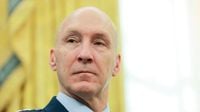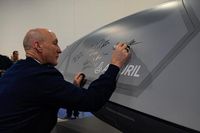General David Allvin, the United States Air Force’s top uniformed officer, has announced his retirement, sending ripples through the military community and sparking debate over the direction of U.S. defense leadership. Allvin’s decision, revealed on August 18, 2025, comes just under two years into his four-year term as the 23rd Air Force Chief of Staff—a tenure now set to end around November 1, 2025. The move marks the shortest stint for an Air Force chief since 1990 and adds to a growing list of senior military departures under President Donald Trump’s second term.
Allvin’s announcement was both abrupt and, for many, unexpected. According to Military.com and CNN, there was little public indication that Allvin planned to retire early. Some defense officials expressed surprise at the timing, with one telling CNN the move was “very unexpected.” The Air Force’s official statement, while confirming his plans to retire, offered no explanation for the early exit. Instead, Allvin himself struck a note of gratitude and professionalism in his statement: “I’m grateful for the opportunity to serve as the 23rd Air Force Chief of Staff and I’m thankful for Secretary Meink, Secretary Hegseth and President Trump’s faith in me to lead our service.” He added, “More than anything, I’m proud to have been part of the team of Airmen who live out our core values of integrity, service and excellence every day as we prepare to defend this great nation.”
Behind the scenes, however, the picture appears more complicated. Multiple outlets, including The Washington Post and IBTimes, reported that Allvin’s retirement followed news that Defense Secretary Pete Hegseth intended to push him out—a pattern that has emerged with other top brass since Trump’s return to office. Hegseth, who has been executing a plan to reduce senior military positions in the name of “increased efficiency,” has presided over a remarkable reshaping of the Pentagon’s leadership ranks. Some critics argue these moves are less about efficiency and more about consolidating loyalty at the highest levels of military command.
Allvin’s departure is not an isolated event but part of a dramatic wave of turnover among senior military officials. Since Trump’s second term began, the White House has overseen the firings or removals of Coast Guard Commandant Admiral Linda Fagan in January 2025, General Charles “CQ” Brown Jr. as Chairman of the Joint Chiefs of Staff in February, Chief of Naval Operations Admiral Lisa Franchetti, and Cyber Command chief General Timothy Haugh in April. Even Allvin’s own vice chief of staff, General James Slife, was recently removed by Hegseth. According to Military.com, policy experts say this level of churn is “leaving everyone wondering, who is next?”
The Trump administration, for its part, insists these changes are necessary. Hegseth has publicly defended the moves as part of a broader effort to ensure loyalty and efficiency within the ranks, as well as to cut the number of four-star generals. Yet, this defense has not quelled concerns among observers who see the rapid turnover as potentially destabilizing. Todd Harrison, a fellow at the American Enterprise Institute, told Military.com, “From the outside, it appears that the leadership turmoil is continuing at senior levels of the Pentagon.”
Amid these political crosscurrents, Allvin’s own record stands out for its breadth and impact. A 1986 graduate of the U.S. Air Force Academy with a degree in Astronautical Engineering, Allvin has spent nearly 40 years in service. He is a command pilot with more than 4,600 flying hours in over 30 different aircraft, and his career has included combat missions, key commands at home and abroad, and strategic roles at the Pentagon. His leadership was instrumental in the unveiling of the new F-47 fighter jet in early 2025 and in advancing multi-domain command and control innovations, aiming to make the Air Force more adaptable for future battlefields.
Secretary of the Air Force Troy Meink was effusive in his praise for Allvin, stating, “The Air Force is fortunate to have leaders like General Dave Allvin. During his tenure, the Air Force has undertaken transformational initiatives that will enable Airmen to answer their nation’s call for decades to come.” Meink also credited Allvin with being “instrumental in my onboarding as the department’s 27th Secretary,” and said he was “forever grateful for his partnership as well as his decades of exemplary service to our nation.”
Allvin’s tenure was marked not only by technological modernization but also by efforts to reshape deployment strategies and increase competition with rivals such as China. He oversaw the creation of new commands, the reestablishment of warrant officers, and the opening of new offices within Air Force headquarters, all designed to prepare Airmen for the evolving demands of global security. Some of these efforts, initially formulated under former Air Force Secretary Frank Kendall, have faced criticism for being underfunded or too narrowly focused. Early in 2025, Hegseth paused at least some of these initiatives, aligning with his focus on raising military standards and enforcing stricter regulations—a move that, according to Military.com, was not always popular among the rank and file.
Allvin’s commitment to the well-being of Airmen was widely recognized. Alex Wagner, the former assistant secretary of the Air Force for manpower and reserve affairs, told Military.com, “I have no idea about his political views, but after seeing him in action for the last few years, I know that Gen. Allvin took seriously his oath to the Constitution and his responsibility for the well-being of the men and women of the Air Force.” Wagner added pointedly, “Apparently, that kind of integrity is disqualifying for Peter Hegseth and Donald Trump, where loyalty means something entirely different.”
Allvin’s decision to remain in his post until a successor is confirmed has been viewed as a mark of professionalism, ensuring a smooth leadership transition. Policy experts, such as Katherine Kuzminski at the Center for a New American Security, noted, “Regardless of the reason for his early departure, he is navigating the civ-mil norms professionally in the way he announced his departure and his willingness to provide a warm handoff to his successor.”
As the Air Force prepares for yet another leadership transition, the uncertainty surrounding Allvin’s departure lingers. No successor has been named, and the Air Force has promised a retirement ceremony “with full honors” later this year. Allvin’s legacy, however, appears secure—his nearly four decades of service, his push for modernization, and his steady hand during a turbulent era will be remembered by colleagues and subordinates alike.
In a period of political upheaval and shifting priorities, General David Allvin’s early retirement signals not just the end of a distinguished military career, but also a moment of reckoning for the future of American military leadership.

